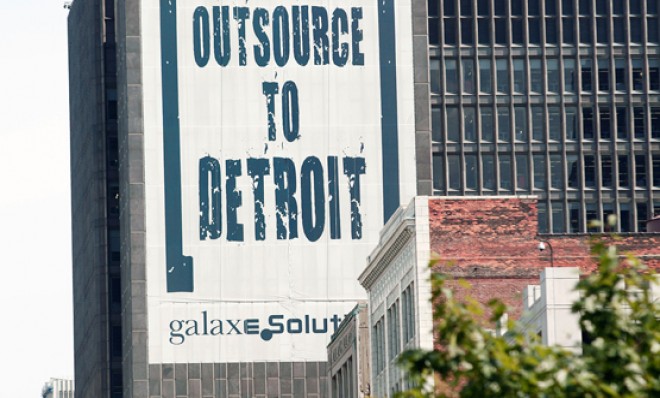What killed Detroit? 3 theories
The city went from being an economic powerhouse to a symbol of urban decay

It wasn't a huge surprise Thursday when Detroit became the largest city in U.S. history to file for Chapter 9 bankruptcy protection.
The city had been synonymous with urban decay for decades, part of a broader collapse of the manufacturing industry in the United States. As the population declined from 1.8 million to under 700,000, at least 80,000 buildings were left abandoned, resulting in an arson epidemic and a visual arts genre known as "ruin porn." And that just skims the surface of a multifaceted problem that includes abysmal levels of crime, a broken education system, and machine politics at its worst.
Now, as the possibility of a federal bailout is debated, experts are asking why Detroit fell apart in the first place — and what other cities can learn from its sad story.
The Week
Escape your echo chamber. Get the facts behind the news, plus analysis from multiple perspectives.

Sign up for The Week's Free Newsletters
From our morning news briefing to a weekly Good News Newsletter, get the best of The Week delivered directly to your inbox.
From our morning news briefing to a weekly Good News Newsletter, get the best of The Week delivered directly to your inbox.
1. The rise of the suburbs
If all the people who fled Detroit since 1950 formed their own city, it would be the 10th-largest in the United States. Many of those people, often the city's wealthier citizens, weren't flocking to other cities; they were heading to nearby suburbs like Birmingham and Bloomfield Hills. That leaves Detroit and its wealthier neighbors in an uncomfortable position, writes Robert Reich, secretary of labor in the Clinton administration:
Between 2000 and 2010, Detroit lost a quarter of its population as the middle-class and whites fled to the suburbs. That left it with depressed property values, abandoned neighborhoods, empty buildings, lousy schools, high crime, and a dramatically-shrinking tax base.
If 'Detroit' is defined as the larger metropolitan area that includes its suburbs, 'Detroit' has enough money to provide all its residents with adequate if not good public services, without falling into bankruptcy. Politically, it would come down to a question of whether the more affluent areas of this 'Detroit' were willing to subsidize the poor inner-city through their tax dollars, and help it rebound. That's an awkward question that the more affluent areas would probably rather not have to face. [Huffington Post]
Detroit's sprawling nature has also caused the city problems, since the local government has been forced to provide services to a geographic area big enough to accommodate 1.8 million people, despite having a tax base made up of less than half that many.
2. Lack of economic diversity
A free daily email with the biggest news stories of the day – and the best features from TheWeek.com
Detroit's economic core, the auto industry, was gutted as U.S. auto companies moved their manufacturing elsewhere. Today, according to TIME, there is only one auto plant operating within Detroit's city limits, with others having moved to the suburbs or Southern states like Kentucky, Alabama, and South Carolina.
But Detroit was just one of many cities that suffered during the middle-class exodus to the suburbs in the middle of the 20th century. Not all of those cities, however, are suffering Detroit's fate. Take Pittsburgh, another Rust Belt city with an economy traditionally built mainly around one industry: Steel.
While the Motor City is struggling, Pittsburgh is experiencing something of an economic comeback. The reason, argues Slate's Matthew Yglesias, is Pittsburgh's focus on diversifying its economy after the steel industry dried up. The city's two prestigious universities — Carnegie Mellon and the University of Pittsburgh — served as the catalysts for change:
Universities both create little neighborhood-level retail clusters around them, and along with medical facilities become the twin pillars of a regional knowledge-based economy. Of course cities can thrive without necessarily playing host to a prestigious private university or a public university flagship campus (San Antonio, for example) but for lots of older cities hit hard by the macroeconomic trends of the 1970s and 1980s the existence of major universities has provided a foundation for rebuilding. [Slate]
Today, Pittsburgh is home to growing biotech, robotics, health care, finance, and education industries. "Detroit might have a harder time pulling a Pittsburgh," writes TIME's Bill Saporito, because it "can't claim any world-class universities that will develop the next wave of industry."
That doesn't mean it can't invest in the major university it does have, Wayne State, or work with nearby prestigious schools like the University of Michigan in Ann Arbor to develop new industries within the city to complement a somewhat rebounding auto industry.
3. Bad governance
While market forces did have a hand in Detroit's downfall, many are pointing to the city's record of terrible governance. The most recent example of Detroit's dysfunctional government is Kwame Kilpatrick, who served as mayor from 2002 to 2008, and is now facing 20 years in prison after being convicted of extortion, bribery, and racketeering.
But the blame isn't on Kilpatrick alone, writes The Washington Post's Jena McGregor:
It’s a city where union leaders have long held unrealistic and short-sighted goals which, combined with their unparalleled power, exacerbated the industry’s problems and the city’s employment prospects. It’s a city where some of the region’s representatives in Washington have historically been so defending of those industries and their unions that they failed to diversify its economic base...
More recently, this is a city where there have been five police chiefs in five years. Where a report by the city’s emergency manager called Detroit’s operations "dysfunctional and wasteful after years of budgetary restrictions, mismanagement, crippling operational practices, and, in some cases, indifference or corruption." [The Washington Post]
After already severely cutting services to its residents, Detroit will now have to grapple with how to deal with the $3.5 billion in pension obligations that make up a large chunk of its $18 billion in debt.
Some conservatives, such as The Heritage Foundation's Rich Tucker, are saying Detroit's bankruptcy is an example of organized labor run amok, and a real-world indictment of big government liberalism. Progressives, however, argue that even without the politicians like Kilpatrick, Detroit sill would have been in trouble.
"There are influential people out there who would like you to believe that Detroit’s demise is fundamentally a tale of fiscal irresponsibility and/or greedy public employees," writes The New York Times' Paul Krugman. "It isn't. For the most part, it’s just one of those things that happens now and then in an ever-changing economy."
Keith Wagstaff is a staff writer at TheWeek.com covering politics and current events. He has previously written for such publications as TIME, Details, VICE, and the Village Voice.


